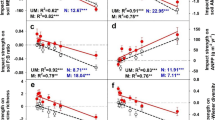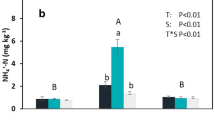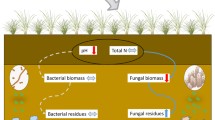Abstract
Purpose
Microbes play a key role in soil nutrient cycling and supply in the extensive semiarid grassland ecosystem, where no fertilizers are applied. However, the role of fungi vs bacteria in nitrogen (N) mineralization in such ecosystem is poorly understood. The objective of this study was to determine the impacts of different mowing practices on fungal and bacterial communities and the relationships between the two microbial communities and net N mineralization rate (R m).
Materials and methods
This study was based on a 13-year mowing experiment in Inner Mongolia. The treatments included mowing once every second year (M1/2), mowing twice every 3 years (M2/3), mowing once a year (M1), mowing twice a year (M2), and the unmown (control, CK). Soil basic chemical properties, R m, microbial biomass, bacterial and fungal community abundance, and diversity were determined, and fungal phylogeny and the relationship between microbial community and R m were analyzed.
Results and discussion
Moderate mowing (M1/2, M2/3, and M1) enhanced soil carbon and nitrogen stocks, R m, fungal community abundance and diversity which might mainly because of the increased decomposer fungi species, but the higher frequency mowing (M2) significantly decreased the above. There was a significant correlation between fungal community abundance and R m (r = 0.688, P = 0.005) in this study. However, different mowing practices had little effect on the bacterial community, which might due to human disturbance (mowing practices) and poor environmental conditions (drought, limited available nitrogen and phosphorus).
Conclusions
Overall, fungi may play a more important role than bacteria in N mineralization under mowing management in such a grassland ecosystem. Moderate-frequency mowing, e.g., M1, is more appropriate for maintaining soil microbial communities and soil fertility, whereas the high-frequency mowing, e.g., M2, is not sustainable for maintaining soil nutrients and microbial community in such a semiarid grassland ecosystem in a long term.




Similar content being viewed by others
References
Adair KL, Wratten S, Lear G (2013) Soil phosphorus depletion and shifts in plant communities change bacterial community structure in a long-term grassland management trial. Env Microbiol Rep 5:404–413
Andresen LC, Dungait JA, Bol R, Selsted MB, Ambus P, Michelsen A (2014) Bacteria and fungi respond differently to multifactorial climate change in a temperate heathland, traced with 13C-glycine and FACE CO2. PLoS One 9:e85070
Bao SD (2000) Analytical methods for soil and agricultural chemistry. China Agriculture Science and Technology Press, Beijing (in Chinese)
Baoyin T, Li FY, Bao Q, Minggagud H, Zhong Y (2014) Effects of mowing regimes and climate variability on hay production of Leymus chinensis (Trin.) Tzvelev grassland in northern China. Rangel J 36:593–600
Bell TH, Hassan SE, Lauron-Moreau A, Al-Otaibi F, Hijri M, Yergeau E, St-Arnaud M (2014) Linkage between bacterial and fungal rhizosphere communities in hydrocarbon-contaminated soils is related to plant phylogeny. The ISME J 8:331–343
Benot M-L, Saccone P, Pautrat E, Vicente R, Colace M-P, Grigulis K, Clément J-C, Lavorel S (2014) Stronger short-term effects of mowing than extreme summer weather on a subalpine grassland. Ecosystems 17(3):458-472
Binet MN, Sage L, Malan C, Clément JC, Redecker D, Wipf D, Mouhamadou B (2013) Effects of mowing on fungal endophytes and arbuscular mycorrhizal fungi in subalpine grasslands. Fungal Ecol 6:248–255
Boyle SA, Yarwood RR, Bottomley PJ, Myrold DD (2008) Bacterial and fungal contributions to soil nitrogen cycling under Douglas fir and red alder at two sites in Oregon. Soil Biol Biochem 40:443–451
Bremner JM (1965) Total nitrogen. In: Black CA (ed) Methods of soil analysis, part 2. Soil Science Society American, Madison, pp. 1149–1178
Brookes PC, Landman A, Pruden G, Jenkinson DS (1985) Chlorofrom fumigation and the release of soil nitrogen: a rapid extraction method to measure microbial biomass nitrogen in soil. Soil Biol Biochem 17:837–842
Cardinale BJ, Duffy JE, Gonzalez A, Hooper DU, Perrings C, Venail P, Kinzig AP (2012) Biodiversity loss and its impact on humanity. Nature 486:59–67
Cardinale BJ, Srivastava DS, Duffy JE, Wright JP, Downing AL, Sankaran M, Jouseau C (2006) Effects of biodiversity on the functioning of trophic groups and ecosystems. Nature 443:989–992
Chemidlin Prevost-Boure N, Christen R, Dequiedt S, Mougel C, Lelievre M, Jolivet C, Ranjard L (2011) Validation and application of a PCR primer set to quantify fungal communities in the soil environment by real-time quantitative PCR. PLoS One 6:e24166
Chen H, Mothapo NV, Shi W (2015) Soil moisture and pH control relative contributions of fungi and bacteria to N2O production. Micro Ecol 69:180–191
Chen Y, Hu H, Han HY, Du Y, Wan SQ, Xu ZW, Chen BD (2014) Abundance and community structure of ammonia-oxidizing archaea and bacteria in response to fertilization and mowing in a temperate steppe in Inner Mongolia. FEMS Microbiol Ecol 89:67–79
Cong W, van Ruijven J, Mommer L, De Deyn GB, Berendse F, Hoffland E (2014) Plant species richness promotes soil carbon and nitrogen stocks in grasslands without legumes. J Ecol 102:1163–1170
de Lima Brossi MJ, Jiménez DJ, Cortes-Tolalpa L, van Elsas JD (2016) Soil-derived microbial consortia enriched with different plant biomass reveal distinct players acting in lignocellulose degradation. Microb Ecol 71:616–627
Dolci P, Barmaz A, Zenato S, Pramotton R, Alessandria V, Cocolin L, Ambrosoli R (2009) Maturing dynamics of surface microflora in Fontina PDO cheese studied by culture-dependent and -independent methods. J Appl Microbiol 106:278–287
Evans TN, Watson G, Rees GN, Seviour RJ (2014) Comparing activated sludge fungal community population diversity using denaturing gradient gel electrophoresis and terminal restriction fragment length polymorphism. Anton Leeuw Int J Gen Mol Microbiol 105:559–569
Fierer N, Jackson JA, Vilgalys R, Jackson RB (2005) Assessment of soil microbial community structure by use of taxon-specific quantitative PCR assays. Appl Env Microbiol 71:4117–4120
Fornara DA, Tilman D (2008) Plant functional composition influences rates of soil carbon and nitrogen accumulation. J Ecol 96:314–322
Fornara DA, Tilman D (2009) Ecological mechanisms associated with the positive diversity-productivity relationship in a N-limited grassland. Ecology 90:408–418
Gianinazzi S, Gollotte A, Binet M, van Tuinen D, Redecker D, Wipf D (2010) Agroecology: the key role of arbuscular mycorrhizas in ecosystem services. Mycorrhiza 20:519–530
Gordon H, Haygarth PM, Bardgett RD (2008) Drying and rewetting effects on soil microbial community composition and nutrient leaching. Soil Biol Biochem 40:302–311
Grigulis K, Lavorel S, Krainer U, Legay N, Baxendale C, Dumont M, Pommier T (2013) Relative contributions of plant traits and soil microbial properties to mountain grassland ecosystem services. J Ecol 101:47–57
Herold MB, Baggs EM, Daniell TJ (2012) Fungal and bacterial denitrification are differently affected by long-term pH amendment and cultivation of arable soil. Soil Biol Biochem 54:25–35
Herold N, Schoening I, Gutknecht J, Alt F, Boch S, Müller J, Schrumpf M (2014) Soil property and management effects on grassland microbial communities across a latitudinal gradient in Germany. Appl Soil Ecol 73:41–50
Högberg MN, Hogberg P, Myrold DD (2007) Is microbial community composition in boreal forest soils determined by pH, C-to-N ratio, the trees, or all three? Oecologia 150:590–601
Ives AR, Carpenter SR (2007) Stability and diversity of ecosystems. Science 317:58–62
Kalembasa SJ, Jenkinson DS (1973) A comparative study of titrimetric and gravimetric methods for the determination of organic carbon in soil. J Sci Food Agr 24:1085–1090
Kjøller A, Struwe S (1982) Microfungi in ecosystems: fungal occurrence and activity in litter and soil. Oikos 39:391–422
Lane DJ (1991) 16S/23S rRNA Sequencing. In: Stackebrandt E, Goodfellow M (eds) Nucleic acid techniques in bacterial systematics. John Wiley and Sons, Inc., New York, pp. 115–175
LeBauer DS, Treseder KK (2008) Nitrogen limitation of net primary productivity in terrestrial ecosystems is globally distributed. Ecology 9:371–379
LeBlanc N, Kinkel LL, Kistler HC (2015) Soil fungal communities respond to grassland plant community richness and soil edaphics. Microb Ecol 70:188–195
LeeAnna YC, Steven G, Sun G, Zhang Y (2013) Net nitrogen mineralization in natural ecosystems across the conterminous US. Int J Geosci 4:1300–1312
Letcher PM, Powell MJ, Barr DJ, Churchill PF, Wakefield WS, Picard KT (2008) Rhizophlyctidales is a new order in Chytridiomycota. Mycol Res 112:1031–1048
Li T, Lin G, Zhang X, Chen Y, Zhang S, Chen B (2014) Relative importance of an arbuscular mycorrhizal fungus (Rhizophagus intraradices) and root hairs in plant drought tolerance. Mycorrhiza 24:595–602
Lin XG (2010) Principles and methods of soil microbiology research. Higher Education Press, Beijing, p. 225 (in Chinese)
Liu M, Liu GH, Wu X, Wang H, Chen L (2014) Vegetation traits and soil properties in response to utilization patters of grassland in Hulun Buir City, Inner Mongolia, China. Chinese Geographic Science 24:471–478
Luo P, Han X, Wang Y (2015) Influence of long-term fertilization on soil microbial biomass, dehydrogenase activity, and bacterial and fungal community structure in a brown soil of northeast China. Ann Microbiol 65:533–542
Mariotte P, Robroek BJ, Jassey VE, Buttler A (2015) Subordinate plants mitigate drought effects on soil ecosystem processes by stimulating fungi. Funct Ecol 29:1578–1586
Mariotte P, Vandenberghe C, Meugnier C, Rossi P, Bardgett RD, Buttler A (2013) Subordinate plant species impact on soil microbial communities and ecosystem functioning in grasslands: findings from a removal experiment. Perspect Plant Ecol 15:77–85
Marquard E, Weigelt A, Temperton VM, Roscher C, Schumacher J, Buchmann N, Schmid B (2009) Plant species richness and functional composition drive overyielding in a six-year grassland experiment. Ecology 90:3290–3302
Matsumoto H, Koganei K, Nishida N, Koyama Y, Saito S, Kataoka H, Kasumi T (2014) Cell dispersion culture for the effective growth of Humicola insolens and efficient enzyme production. J Biosci Bioeng 117:257–262
McHugh TA, Koch GW, Schwartz E (2014) Minor changes in soil bacterial and fungal community composition occur in response to monsoon precipitation in a semiarid grassland. Microb Ecol 68:370–378
Muyzer G, de Waal EC, Uitterlinden AG (1993) Profiling of complex microbial populations by denaturing gradient gel electrophoresis analysis of polymerase chain reaction-amplified genes coding for 16S rRNA. Appl Environ Microbiol 59:695–700
Oelmann Y, Buchmann N, Gleixner G, Habekost M, Roscher C, Rosenkranz S, Weisser WW (2011) Plant diversity effects on aboveground and belowground N pools in temperate grassland ecosystems: development in the first 5 years after establishment. Global Biogeochem Cy 25:415–421
Robson TM, Lavorel S, Clement JC, Le Roux X (2007) Neglect of mowing and manuring leads to slower nitrogen cycling in subalpine grasslands. Soil Biol Biochem 39:930–941
Rousk J, Bååth E, Brookes PC, Lauber CL, Lozupone C, Caporaso JG, Fierer N (2010) Soil bacterial and fungal communities across a pH gradient in an arable soil. The ISME J 4:1340–1351
Rousk J, Brookes PC, Bååth E (2009) Contrasting soil pH effects on fungal and bacterial growth suggest functional redundancy in carbon mineralization. Appl Env Microbiol 75:1589–1596
Schimel JP, Bennett J (2004) Nitrogen mineralization: challenges of a changing paradigm. Ecology 85:591–602
Shannon CE, Weaver W (1949) The mathematical theory of communication. University of Illinois Press, Urbana
Shoun H, Funshinobu S, Jiang L, Kim SW, Wakagi T (2012) Fungal denitrification and nitric oxide reductase cytochrome P450nor. Philos T R Soc B 367:1186–1194
Socher SA, Prati D, Boch S, Müller J, Klaus VH, Hölzel N, Fischer M (2012) Direct and productivity-mediated indirect effects of fertilization, mowing and grazing on grassland species richness. J Ecol 100:1391–1399
Stephan A, Meyer AH, Schmid B (2000) Plant diversity affects culturable soil bacteria in experimental grassland communities. J Ecol 88:988–998
Strickland MS, Rousk J (2010) Considering fungal: bacterial dominance in soils–methods, controls, and ecosystem implications. Soil Biol Biochem 42:1385–1395
Suttie JM (2000) Hay and straw conservation. FAO Plant production and protection series No. 29 (FAO: Rome, Italy)
Talbot JM, Treseder KK (2010) Controls over mycorrhizal uptake of organic nitrogen. Pedobiologia 53:169–179
Tamura K, Stecher G, Peterson D, Filipski A, Kumar S (2013) MEGA6: molecular evolutionary genetics analysis version 6.0. Mol Biol Evol 30(12):2725–2729
Vainio EJ, Hantula J (2000) Direct analysis of wood-inhabiting fungi using denaturing gradient gel electrophoresis of amplified ribosomal DNA. Mycol Res 104:927–936
Wu J, Joergensen RG, Pommerening B, Chaussod R, Brookes PC (1990) Measurement of soil microbial biomass C by fumigation extraction: an automated procedure. Soil Biol Biochem 22:1167–1169
Wu TH (2011) Can ectomycorrhizal fungi circumvent the nitrogen mineralization for plant nutrition in temperate forest ecosystems? Soil Biol Biochem 43:1109–1117
Yang H, Jiang L, Li L, Li A, Wu M, Wan S (2012) Diversity-dependent stability under mowing and nutrient addition: evidence from a 7-year grassland experiment. Ecol Lett 15:619–626
Yuste JC, Penuelas J, Estiarte M, GARCIA-MAS J, Mattana S, Ogaya R, Sardans J (2011) Drought-resistant fungi control soil organic matter decomposition and its response to temperature. Glob Chang Biol 17:1475–1486
Zaman M, Di HJ, Cameron KC, Cameron KC, Frampton CM (1999) Gross nitrogen mineralization and nitrification rates and their relationships to enzyme activities and the soil microbial biomass in soils treated with dairy shed effluent and ammonium fertilizer at different water potentials. Biol Fert Soils 29:178–186
Zhang LX, Bai YF, Han XG (2004) Differential responses of N : P stoichiometry of Leymus chinensis and Carex korshinskyi to N additions in a steppe ecosystem in Nei Mongol. Acta Bot Sin 46:259–270
Zhang X, Chen Q, Han X (2013) Soil bacterial communities respond to mowing and nutrient addition in a steppe ecosystem. PLoS One 8:e84210
Acknowledgments
The authors thank the support of Inner Mongolia Grassland Ecosystem Research Station of the Chinese Academy of Sciences. This work was financially supported by the National Key Basic Research Program of China (2014CB138801) and the National Natural Science Foundation of China (41271272 and 41401266).
Author information
Authors and Affiliations
Corresponding author
Additional information
Responsible editor: Yanfen Wang
Electronic supplementary material
Fig S1
Effects of mowing on MBC (a), MBN (b) and MBC/MBN (c) in soil. MBC, microbial biomass carbon. MBN, microbial biomass nitrogen, MBC/MBN ratio, MBC to MBN ratio. Different lowercase letters indicate significant differences (P < 0.05). (PDF 10 kb)
Rights and permissions
About this article
Cite this article
Li, J., Zhang, Q., Li, Y. et al. Impact of mowing management on nitrogen mineralization rate and fungal and bacterial communities in a semiarid grassland ecosystem. J Soils Sediments 17, 1715–1726 (2017). https://doi.org/10.1007/s11368-016-1620-1
Received:
Accepted:
Published:
Issue Date:
DOI: https://doi.org/10.1007/s11368-016-1620-1




